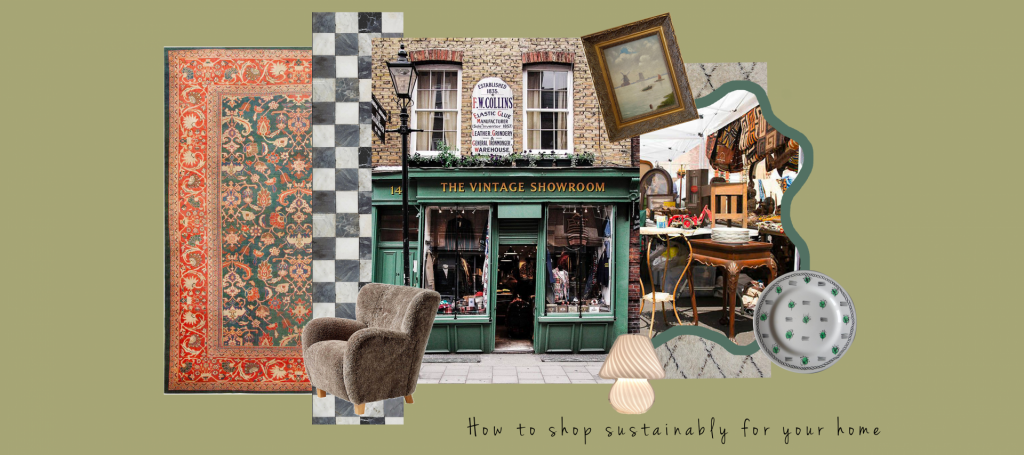
Did you know that about 9 million tons of furniture are dumped into landfills every year? And most of these furniture tossed away were just 10-15 years old. Mainly due to poor design quality and the fact that it is easier to just buy a new one rather than taking the time and money to repair those pieces lacking character. Something is telling us that fast furniture is another environmental fiasco we should think about and see if we can minimize.
Luckily, it seems that our shopping appetite is shifting towards more unique goods and preferably second handed. This could be a great counter solution only if we do it right.
Considering donating our goods, that we don’t want anymore, to local non profits or selling them (even damaged) on marketplaces instead of dumping is perhaps the first step toward positive change. There will always be someone interested. Then, if we want to be sustainable and keep our costs down while maintaining a unique style, it is our turn to source second hand. Not so simple!
Surely, you must have noticed by now the recent craze for vintage home furnishings and perhaps wonder what’s going on with all that vintage craze? Stores in Brooklyn selling out in a matter of seconds a 1970 Mads Caprani curved lamp or the euphoria for some high-priced couch under some Italian name you’ve never heard of. Don’t look any further! The word is out on social media. Influencers are paving the way – after “fashion news cycle”, the new chapter is all about “get my living room look” and it’s breaking the inventory. The demand for top vintage and antique categories like rugs, desks, table lamps is up at least 20 percent on the online marketplace 1stdibs with some categories up as much as 80 percents. How on earth are we going to be able to shop properly with all that mass hunger? Because there is one thing we cannot change about secondhand pieces, they are very limited – giving us no time to prevaricate or to think through “will this really fit my place?” or “is this really what I want?’. Social shopping is without a doubt creating a feeling of anxiety through the pressure of scarcity. Let’s not fall for it, even though it’s tempting.
Trends are so hard to avoid. We are drunk with what we see on social media. Overwhelmed, they often play with what we truly want and what we are influenced to want. So, the key to shopping sustainably is to be honest with ourselves. There is no wrong in taste, as long it is truly something we cherish. This doesn’t mean we need to ditch trends, it would be clearly misunderstanding them. They are a great source of information, helping us to see what’s available. The goal here is to learn how to use them without losing ourselves. You need to ask yourself ‘why do I want this new thing? Is it because I’ve seen it too many times on my feed?”. Resisting the urge and trying to wait a few days even weeks to see if this new addition is the right choice is truly transformative. You might be surprised how many expensive mistakes you might avoid by setting boundaries and moving beyond compulsive patterns.
In the secondhand world, to qualify as real vintage furniture, a piece should be at least 30 to 40 years old. Anything more than 100 years old is considered antique. If you are looking at sourcing true vintage or antique gems without breaking the bank or being scammed, here is what a first-time buyer should know: buying vintage requires some skills, especially online. First of all, we should be all concerned about where, when and how the piece we seek was made beyond wanting to buy a look. Most of the expensive pieces are costly because they were made from the finest materials by highly skilled and renowned furniture makers. Something rare and admired today. However, with the increasing demand and the opportunity that goes with it, we are seeing a lot more replicas made from fast furniture with quality that doesn’t always justify the price.
Search for the item name, which country it is from, who designed or made it, when. Furniture companies and makers often listed their name, location and year of production on a sticker, a label or a stamp. This information can be found on the object as proof of authenticity. For example, if you are looking for a Murano mushroom lamp, you should be looking for a Vetri Venini sticker on it.
Consider making a list of trust sellers and visit frequently. Local independent stores, online marketplaces such as eBay, 1stDibs, Etsy, Chairish, OneKingLane, flea markets, vintage and antiques fairs.
A true vintage or antique piece shouldn’t be looking sparkling new. Same goes if the item is falling apart. These products were made in long-lasting materials.
There is no need to spend loads to buy vintage. Just don’t look too much at what and where everyone else is buying. You never know what you might find sourcing outside of the box. Lucky acquisitions happen more often than we think. Just like that time I found a pair of beautiful Italian table lamps from Barovier & Toso 1950s for less than 100 dollars.
Hunting down vintage pieces is fun but has its limits. The amount of new designers and makers on the market today is on the rise and supporting good modern designs is also a way to shop sustainably. Of course, shopping locally will most likely guarantee a more transparent and thoughtful production process, rather than something shipped from overseas. You might be surprised to see how many affordable local artists and makers are around you. Check out our article series “meet the maker” (coming soon).
Xx
Share this Superb article – print | twitter | facebook | pinterest | email